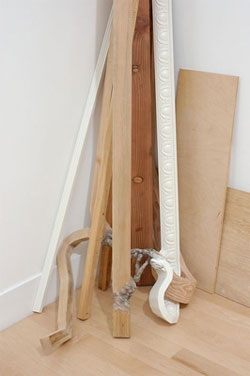
Christian Maychack at Gregory Lind Gallery
by Joseph del Pesco
July 2, 2007
Pulling down the bricks from the ceiling at SoEx's old exhibition space or appearing as a parasitic echo of the stairway at YBCA, Christian Maychack's site-specific sculptures have regularly appeared at the periphery of group shows. It is in the overlooked infrastructure of gallery spaces that Maychack's work is best situated to rupture the expectations of the viewer. By engaging in a conversation with the site and its materials, the content of his work is pushed beyond abstraction and into the situational.
As a result, isolating the work in the frame of a solo exhibition and presenting it without the counter-point of a more traditional display, poses some challenges. The recent solo exhibition at Gregory Lind encapsulates a collection of responses to this challenge, each with varying degrees of success. These attempts at self-containment range from sculptures on a pedestal to semi-integrated installations. And instead of existing in conversation with a third-party exhibition, the objects in this exhibition tend to speak to one other.
Over the past 5 years Maychack has developed a visual and physical language within his sculptural practice. It is a language that has a material logic (oozing liquid forms or expanding and contracting fragments of geometry) but has never been reduced to the redundancy of repeated forms. The subtle introduction of color particles, meteorite-like capsules, framed folds, and raw wood expand the existing language rather than defy it. Also consistent within this language: each sculpture implies a supernatural movement, as if frozen in a state of transformation between the material real and the amorphous unknown.
In the exhibition at Gregory Lind gallery, Maychack continues to test the limits of this language. His experimentation is particularly successful in works like "All Together Now or The Inherent Capacity of a Woodpile," which defy the site dependence of his past work and imply a new kind of narrative. The smoke-like fingers that animate these materials, turn a pile of forgotten junk into the genesis of an otherworldly presence. Other works however, like the "Untitled" sculpture, where a Sol Lewitt box seems to have crash-landed in a landscape, speak more of miniature representation than a coming-into-being.
The boldest work in the show, "A Thinnest of Betweens," is a three dimensional rorschach, that turns the formal austerity of a symmetrical form into gushing bodily surrogate. Abstraction typically leads viewers to free-associate or project their ideas onto its surface, and the interpretive mechanism of the rorschach seems to reinforce this subjective reading. Yet, the grotesque blubbery form reaching out from the wall, toward the viewer, may be hoping for something more, something felt in the physical realm, yet left undefined and meant to stay that way.